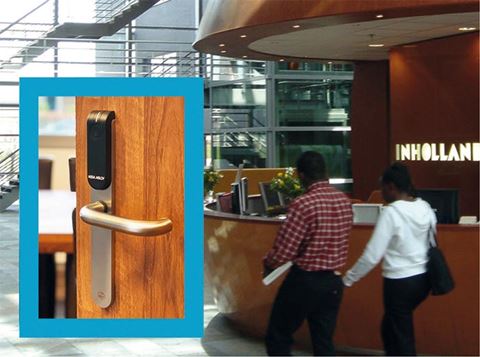In a survey of industry professionals for the Wireless Access Control Report 2021, over 90 per cent of re-spondents noted the importance of integration across building management functions.
“Interoperability is now essential for joined-up security. Security and facility managers want systems which work together seamlessly”, says Russell Wagstaff.
The fact that 90 per cent of respondents noted the importance of integration across building management functions is, while large, hardly a surprise in an increasingly interconnected world. Budget concerns play a role, too. Running systems in parallel, rather than from one integrated control panel, is more expensive and increases errors in data entry and analysis. A single system becomes a more reliable, authoritative record — and therefore makes security auditing easier and more accurate, states Russell Wagstaff, and continues:
“Yet despite this, deeper integration of building systems is still at the planning or “to-do list” stage for many companies. The desire for it remains unfulfilled. Why?”
Shared standards better future-proofed
Over a quarter of respondents (27 per cent) to the same survey suggest a lack of available solutions developed to compatible standards.
“Standards are key for the momentum behind the shift towards system integration. The migration from proprietary or closed technology to open architecture has likely come as a response to the demand for flexibility from end-users, consultants and systems integrators,” notes the Report.
Russell Wagstaff emphasises, as well as being more flexible, solutions developed to shared standards are better future-proofed. Standards ensure investments may be made today with confidence that hardware and firmware can be built on seamlessly in the future. Compatible solutions offer greater peace of mind than proprietary solutions which ‘lock customers in’ for the long term.
“On top of this shortage of integration-ready solutions, another quarter of survey respondents (26 per cent) highlighted a lack of integration expertise in general. Fortunately, both of these roadblocks can be removed, with the right choice of solution. Hardware and software integration are two different paths towards the same goal. When end-users match the application to the right integration strategy, the result is powerful enhancement of building management capability with minimal disruption to their day-to-day business”, he says
Wire-free integration to extend access control
The principal challenge of hardware integration is to do it in a way which enhances – rather than complicates – the way building systems and organisations work. Russell Wagstaff stresses, for almost any site, expanding coverage of traditional wired locks to more doors can be expensive and disruptive. Installing and integrating wireless locks instead is usually much more cost-effective, because no cabling or invasive building work around the door is needed.

“A published API for rapid, hassle-free integration should be an essential element of any wireless locking technology on the shortlist. This way, businesses which already have wired access control and want to enhance their system can do so easily while retaining their existing RFID credential technologies. The ideal wireless locks are sold ready to integrate with security systems from multiple OEMs worldwide. Rather than increase the complexity of security management, they simplify it”, Russell Wagstaff says.
Assa Abloy stresses that wireless, battery-powered cylinders, escutcheons, handles and locks with builtin RFID and mobile credential readers can of course be fitted as a new access control system. They can also extend an existing installation by linking new doors, servers or cupboards to the same security system, without the hassle and expense of electrical cabling.
Efficiency benefits of hardware integration
Russell Wagstaff believes hardware integration makes security management more efficient: When staff use fewer interfaces, less training is required. The job gets done quicker, because systems are familiar. Integration also enhances the experience for building users.
“One credential can open the car park, then the building entrance, and perhaps unlock their laptop, book a meeting room and buy lunch in the cafe”, he says.
At the Inholland University of Applied Sciences, for example, a rolling project to upgrade access control has been ongoing for many years. More than 500 wireless, battery-powered door devices are now deployed at seven separate Inholland campuses. All Inholland’s electronic locking devices are integrated with the university’s central access system. With a single credential, users unlock all authorised openings managed by the system, whether wired or wire-free doors.
Russell Wagstaff says: “Choosing wireless technology saved the university more than just time. A recent in-house benchmarking study found installer labour costs are over 80 per cent lower for wireless versus wired locks. The operating cost of running battery-powered wireless locks is also much lower than for equivalent wired locks, which rely on mains electricity.”
Which standards, which platforms?
According to Russell Wagstaff, the easiest, most cost-effective path to hardware integration is with products developed to agreed standards. Integration-ready standards future-proof any large investment in access control – and most investments in security are large.
In the vast global security ecosystem, multiple standards play an important role. They demand cooperation at the top, in an industry that also thrives on competition. The Open Supervised Device Protocol (OSDP) is deployed across the access industry, including by HID Global. Suited to highersecurity applications, including in government, the OSDP supports AES-128 encryption, bi-directional communications and biometric smartcards. Again, interoperability is at the heart of the OSDP’s mission.
Another, newer access control standard is also making an impact, Russell Wagstaff stresses. When asked to assess whether locks should support the OSS Standard Offline (OSS–SO), a majority of professionals polled for the 2018 edition of the Wireless Access Control Report judged it was “very important” (58 per cent). Again, flexibility and future-proofing were mentioned. A huge majority (91 per cent) considered it at least “somewhat important”.
With the OSS–SO, offline locks from different manufacturers read access rights from a card and interpret them in the same way. It is possible to bake this standard into firmware for an entire product line: If the firmware already complies with the standard, compatible systems support it already, with no additional integration workload for new products.
“Customers see huge benefits of an open standard like the OSS Standard Offline. Open platform development dramatically cuts a customer’s dependence on a single supplier, leaving them free to choose the best device for the job. Open standards offer more frequent opportunities to tender projects, because you are freed from compatibility concerns. Ultimately, that can be a significant cost advantage,” said Frederik Hamburg, Chairman of the Open Standards Security Association.
Software integration for comprehensive building control
There is another path to access control integration: via software. Security software can extend the reach or capability of access control just as powerfully as hardware.
Russell Wagstaff says: “To achieve this, access control software can be “plugged in” directly to an existing building or security management platform, making wired or wire-free electronic doors one node in a larger building control panel. Administrators continue to issue, amend or cancel credentials, including with fine-grained access rules, without leaving their familiar interface.”
As buildings are tasked with getting smarter, this exchange of data between integrated systems becomes ever more important.
According to one Omdia analyst: “Access control integration is essential to unlocking the potential of higher-level BMS (Building Management System) platform functionality. As more BMS solutions move towards command-andcontrol- style features, which allow buildings to adjust building management subsystems to respond to individual occupants’ actions, the need for access-control integration grows exponentially”.
Access control becomes the business software hub
Alternatively, the access control platform itself can expand to manage multiple business processes – HR, support ticketing, financial reporting and more alongside daily access control tasks, for instance. Running multiple systems may create double or triple the work. This can quickly eat into a staff training budget. Duplicating data entry also increases the chance of errors. Boosting the capability of access management software can transform it into the organisation’s “one hub for everything”, hosted locally or accessed via a reliable Software as a Service (SaaS) provider, Assa Abloy stresses.
Access control providers, including Assa Abloy Opening Solutions, increasingly focus on software to improve the power and performance of their systems. The data locked inside an access system can help contribute to achieving business goals such as cost savings, improving energy efficiency or meeting sustainability targets.
Better, more integrated software streamlines decision-making, informing it with data drawn from the security system. It also frees security managers from their desk if such data can be made available inside convenient mobile tools. Tailored reporting, smart visualisation and customisable dashboards help security managers generate valuable insights and then share them with decision-makers and stakeholders around the business.
It unlocks the data that an access system generates every hour of every day. This can be a critical resource and a competitive edge in the hunt for improved profitability. It is also freely available. However, integration is approached, when done effectively it helps customers to broaden their access control capability, administer locking more efficiently, and better protect all kinds of premises from increasingly sophisticated threats.
Deep integration of access control technologies extends a security manager’s capabilities powerfully, but almost totally out of sight. For either a hardware or softwareled approach, this is the goal of successful integration”, Russell Wagstaff concludes.
Source: SECURITYWORLDMARKET


